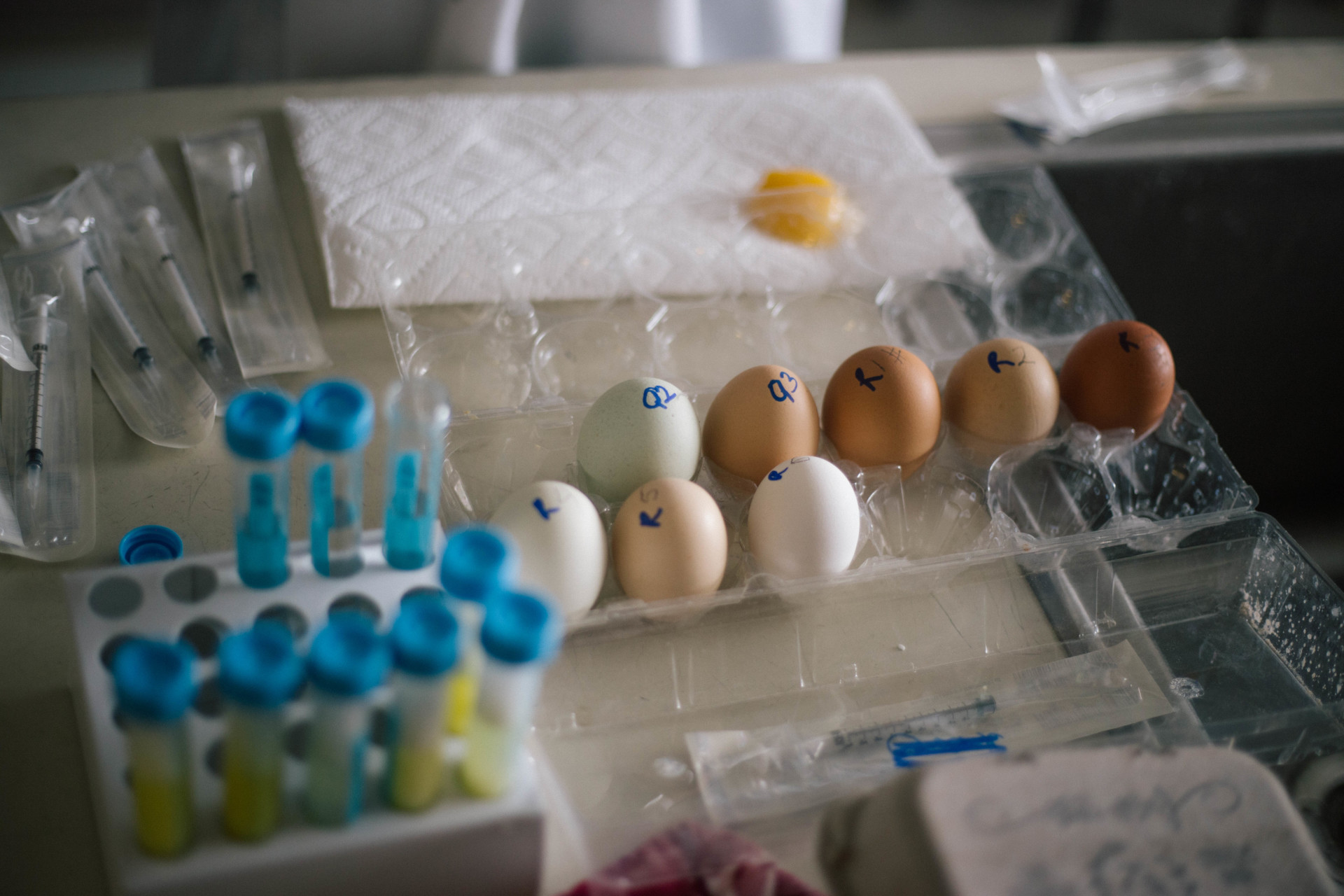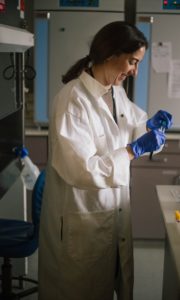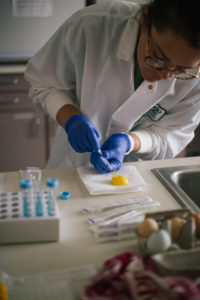
Seven labs at CSU are investigating different aspects of West Nile Virus ecology and transmission. One of the projects, led by Dr. Angela Bosco-Lauth, is examining antibodies to the virus in chicken eggs. Photos: Kellen Bakovich/CSU
Over the last five months, Dr. Angela Bosco-Lauth, a veterinary scientist at Colorado State University, has returned home at the end of the day to find a pile of eggs.
The eggs aren’t for dinner. She’s leading a unique project, studying eggs from backyard chickens to learn more about the spread of West Nile virus. Local residents, who’ve volunteered to share eggs, drop them off at her house, providing a few details on their location in Northern Colorado.
This research is part of a larger project — involving multiple labs and local partners —spearheaded by Dr. Sue VandeWoude, director of CSU’s One Health Institute.
The aim is to help inform policy management and West Nile virus mitigation in Northern Colorado at a time when West Nile virus numbers are the highest they’ve been in years. The Colorado Department of Public Health & Environment has tallied 139 human cases and six deaths, with nearly 90 people hospitalized. The typical season for the virus runs from May to October.
How are animals affected by West Nile virus?

An assistant professor in CSU’s Department of Biomedical Sciences, Bosco-Lauth first began studying West Nile virus in 2005. She’s a self-described horse lover and bought her first equine shortly after moving to Colorado in 2002 when she began her undergraduate studies at the University.
At the time, the U.S. was experiencing the largest West Nile virus epidemic ever in the western hemisphere. Large numbers of birds, horses and other equines and mosquitoes were infected with the virus. Much like people, most horses don’t develop signs following infection, but in those who do get sick, almost one-third end up dying.
“I was terrified, worried about something happening to my horse,” she said. “I started getting involved, mostly trying to figure out what’s being done about this, what can we do from a veterinary perspective?”
Bosco-Lauth connected with and started working in the lab of Dr. Richard Bowen, a veterinary scientist who is renowned for studying viral diseases that affect domestic and wild animals and spill over into human populations.
Bowen was working on the development of an equine West Nile virus vaccine in 2003, a few years after the first equine vaccine was approved by the U.S. Department of Agriculture. Today, there are several options for horse owners who want to protect their animals from the deadly virus.
Several of the vaccines Bowen’s team was testing also got approved by the federal government and are still in use.
Bosco-Lauth said that working in the lab was a perfect mix of veterinary medicine and infectious disease work.
“It launched my infectious disease career,” she said. “I was planning on being a clinician prior to that and decided: No way, this is a lot more fun.”
Separating yolks from the whites

On a visit to the Bowen Lab in late summer, Bosco-Lauth and Melissa Chromik, a third-year Doctor of Veterinary Medicine student, were separating the yolks and the whites in the chicken eggs.
After they separated these egg parts, the researchers gently rolled the yolk on a paper towel to remove as much of the white part as possible.
“The white has other serum proteins that we’re trying not to collect,” explained Bosco-Lauth. “We really just want the antibodies.”
They shake up the yolks in test tubes, let them sit in the refrigerator overnight and the next day, they spin the solution in a centrifuge for 25 minutes. The antibodies settle in the top-most portion. Researchers then conduct tests to find those antibodies in CSU’s Biosafety Level 3 facility.
As of early October, Bosco-Lauth and Chromik collected more than 100 eggs from the community. Only seven eggs were clearly confirmed as West Nile virus exposures, based on antibody tests and following a comparison to a control group of chickens.
Bosco-Lauth said she believes the positive tests were from exposures that occurred last year.
“The cases were all over the place this year, which is interesting in itself, but we were not able to identify any major hotspots,” she said. “Next year we’ll collect more eggs with a wider reach and that might help pinpoint high-risk areas for the virus.”
CSU research provides ‘real value’ to the community
Seven labs from three colleges at CSU investigated different aspects of West Nile Virus ecology and transmission during summer and into fall 2021. Led by Dr. Sue VandeWoude, University Distinguished Professor and director of CSU’s One Health Institute, the teams are partnering with the City of Fort Collins, Center for Disease Control and Prevention’s Division of Vector-Borne Diseases lab in Fort Collins and the Rocky Mountain Raptor Program.
VandeWoude said the goal — using multidisciplinary teams — is to help the city ultimately become less reliant on mosquito spraying as one tool to decrease West Nile virus risk for people.
“The number of infected mosquitoes and travel patterns, populations of susceptible birds, local weather patterns, mosquito and bird habitat and whether or not people take actions to decrease their risk of mosquito bites are all factors that determine individual risk of being exposed to, and contracting the virus,” she said.
VandeWoude said that it’s been rewarding to work with the city and other partners on a project that will have real value to the community.
“The diverse set of participants have been very enthusiastic about sharing knowledge and learning what everyone’s expertise is and how they can be part of the larger solution,” she said. “This is the type of project that illustrates how CSU faculty and student expertise can provide real value to our neighbors.”
This research is supported by CSU’s Department of Environmental and Radiological Health Sciences and the Office of the Vice President for Research.